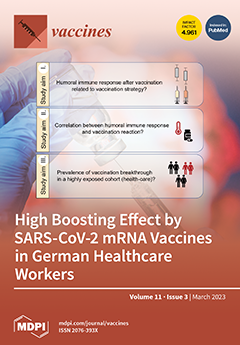Brucellosis is a zoonotic bacterial illness that affects humans and a variety of domestic animals, especially ruminants. It is mostly transmitted through the consumption of contaminated drinks, foods, undercooked meat, or unpasteurized milk or contact with infected animals. Therefore, the present study aimed
[...] Read more.
Brucellosis is a zoonotic bacterial illness that affects humans and a variety of domestic animals, especially ruminants. It is mostly transmitted through the consumption of contaminated drinks, foods, undercooked meat, or unpasteurized milk or contact with infected animals. Therefore, the present study aimed to investigate the seroprevalence of brucellosis in camels, sheep, and goat herds in the Qassim region, Saudi Arabia, using commonly used diagnostic serological procedures such as the Rose Bengal test (RBT), complement fixation test (CFT), and enzyme-linked immunosorbent assay (ELISA). The seroprevalence of brucellosis in camels, sheep, and goats was determined in the selected areas using a cross-sectional study design and a total of 690 farm animals of both sexes of different ages from the three animal species (274 camels, 227 sheep, and 189 goats). According to RBT results, 65 sera were positive for brucellosis, including 15 (5.47%) for camels, 32 (14.09%) for sheep, and 18 (9.50%) for goats. CFT and c-ELISA were performed as confirmatory tests on positive samples resulting from RBT. With c-ELISA, 60 serum samples were confirmed positive, in 14 (5.10%), 30 (13.21%), and 16 (8.46%) camels, sheep, and goats, respectively. There were 59 serum samples confirmed as positive for CFT, including 14 (5.11%), 29 (12.77%), and 16 (8.46%) for camels, sheep, and goats, respectively. Overall, the highest seroprevalence of brucellosis was found in sheep while the least was found in camels from the three tests (RBT, c-ELISA, and CFT). The highest seroprevalence of brucellosis was found in sheep while the least seroprevalence was found in camels. There was also a higher seroprevalence of brucellosis among female animals than males as well as among old animals than young animals. The study, thus, demonstrates brucellosis seroprevalence among farm animals (camels, sheep, and goats) and the significance of intervention measures against brucellosis incidence in both humans and animals through the creation of public awareness and other relevant policy measures such as livestock vaccination, effective hygiene management, and adequate quarantine or serological analysis for newly introduced animals.
Full article






